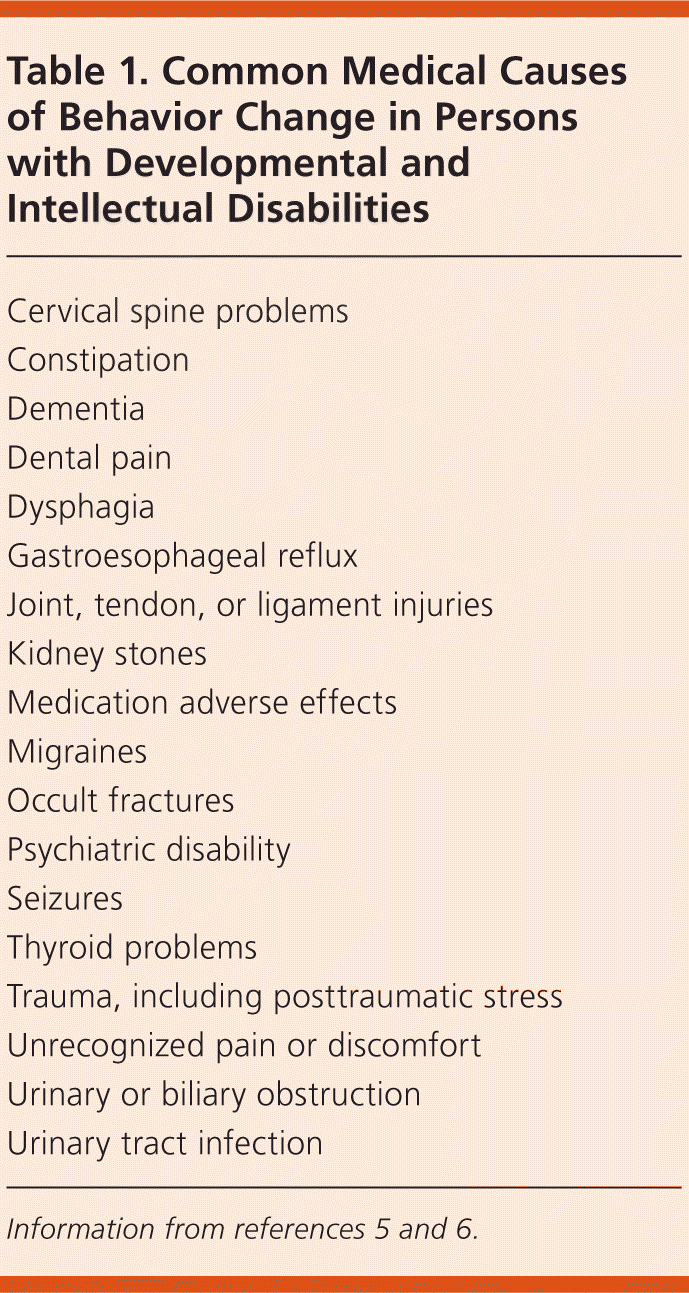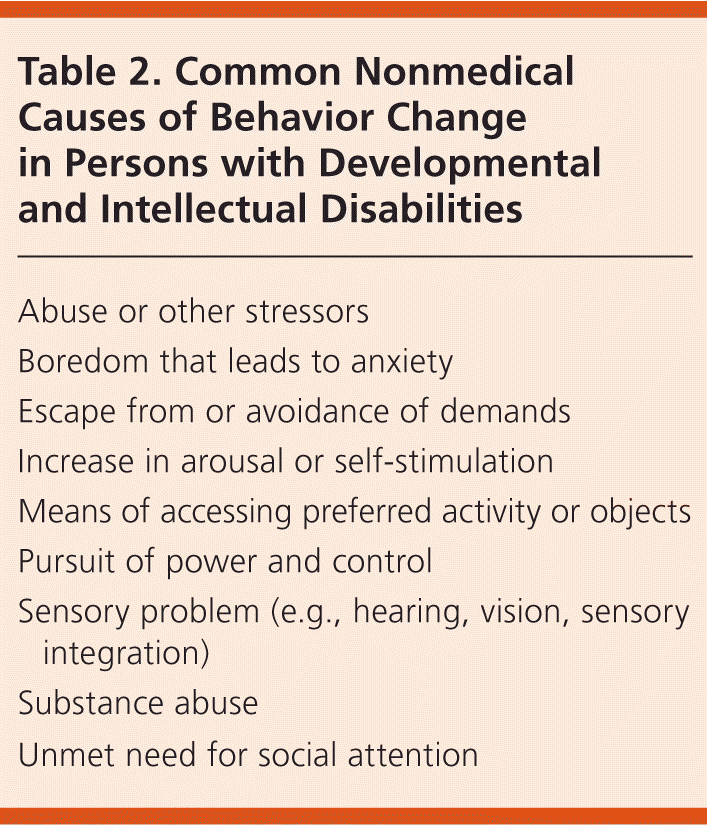
Am Fam Physician. 2016;93(8):686-692
Author disclosure: No relevant financial affiliations.
Case Scenario
A mother brought her 19-year-old nonverbal, autistic son to our clinic. She requested medication for him to reduce the number of episodes that include loud vocalizations, thrashing, and head banging. These episodes usually occur in the car. At baseline, the man has difficulty with movement, characterized by decreased fine-motor control, impulsivity, and sudden darting away. His vision and hearing are normal. He often becomes overstimulated in busy environments. He has a partial complex seizure disorder for which he takes lamotrigine (Lamictal). How can I help this family?
Commentary
When addressing problem behaviors in patients with developmental disabilities, it is critical to understand the underlying reason for their manifestation, particularly if there is a change from baseline behavior or function, and medical causes should always be considered first. The physician's approach should emphasize physical, psychological, and emotional safety for both the patient and his supporter or caregiver, and help the patient build a sense of control and empowerment. Coercion, isolation, restraining measures, harsh or devaluing words, labeling, and focusing on what is “wrong” with the person can be harmful or trigger past trauma. These methods should be avoided by physicians and caregivers or supporters.1,2
INITIAL APPROACH
The physician should begin by clarifying the presenting circumstances using the following questions.
How Does the Patient Communicate Best? The first step is to communicate directly with the patient about his concerns. With the patient's permission, information about the reason for the visit may also come from other persons. However, supporters and caregivers may not recognize all of the relevant signs or symptoms and may not have accurate information.
Being nonverbal is not the same as having nothing to say. Everyone communicates, but that capacity is often overlooked in persons with limited speech, dysmorphic features, or cognitive disabilities. Some persons will communicate best through methods such as writing, typing, pointing to picture icons or letters, sign language, gestures, facial expressions, demonstrations, leading by the hand, sounds, physical signs, or behaviors. For example, behaviors such as darting off, self-injury, or aggression can be a way to communicate distress. However, behaviors that are the result of adaptive, impulsive, or involuntary movements rather than attempts to communicate can be misinterpreted.
Patients often come to appointments with supporters who, like interpreters and cultural brokers, can assist with communication. Information and videos that model how to work effectively with supporters can be found at http://odpc.ucsf.edu/supported-health-care-decision-making. Physicians can encourage patients to complete a personalized accommodations report (http://www.autismandhealth.org/) or health passport (http://odpc.ucsf.edu/sites/odpc.ucsf.edu/files/pdf_docs/FCIC_Health_Passport_Form_Typeable_English.pdf), which can help others understand the patient's needs. Some persons with disabilities can complete these documents independently. Others can complete them with the assistance of a trusted supporter.
Physicians can make simple accommodations such as turning off fluorescent lights, maintaining a scent-free office, allowing extra time for the visit, or using plain language and anatomy pictures or models. These can make a big difference in a patient's ability to participate in his or her own care. Other tips and strategies for working with nontraditional communicators can be found on the website of the University of California, San Francisco's Office of Developmental Primary Care (http://odpc.ucsf.edu).3,4
Is the Behavior a Change from the Patient's Baseline? If the behavior is new, it may be the result of a medical condition or an environmental change. If the behavior is not a change from baseline, it may simply be calming, adaptive, or developmentally appropriate for the patient.
Has the Caregiver's Situation Changed? Sometimes a patient's behaviors are not new, but instead there has been a change in the caregiver's ability to cope. In this case scenario, the son's vocalizations and thrashing may have been manageable until the mother started a carpool or developed migraines.
MEDICAL EVALUATION
Undiagnosed or undertreated medical problems often cause changes in behavior. Simple problems such as constipation or rashes can be very distressing. Sensory processing and communication differences may make it challenging for a patient with disabilities to localize or describe his or her distress. Common medical problems that contribute to behavior change are listed in Table 1.5,6 Physicians should perform a comprehensive physical examination and review of systems, as well as consider a urinalysis and basic metabolic panel. Common problems can also present in unusual ways. For example, hearing changes that result from a buildup of earwax can cause head banging, or reflux can present as insomnia. Patients with disabilities may also not exhibit typical pain behavior, such as moaning, grimacing, and touching the part that hurts.6
Nonmedical causes of behavior change should also be considered (Table 2).

| Cervical spine problems |
| Constipation |
| Dementia |
| Dental pain |
| Dysphagia |
| Gastroesophageal reflux |
| Joint, tendon, or ligament injuries |
| Kidney stones |
| Medication adverse effects |
| Migraines |
| Occult fractures |
| Psychiatric disability |
| Seizures |
| Thyroid problems |
| Trauma, including posttraumatic stress |
| Unrecognized pain or discomfort |
| Urinary or biliary obstruction |
| Urinary tract infection |

| Abuse or other stressors |
| Boredom that leads to anxiety |
| Escape from or avoidance of demands |
| Increase in arousal or self-stimulation |
| Means of accessing preferred activity or objects |
| Pursuit of power and control |
| Sensory problem (e.g., hearing, vision, sensory integration) |
| Substance abuse |
| Unmet need for social attention |
TREATMENT APPROACH
The goal of treatment is to address the cause of behaviors rather than to suppress them in the context of an untenable situation. When discussing these issues, the physician should assume the patient is capable of understanding and participating in his own care, with or without support and accommodation. The physician should also model positive, respectful communication. These attitudes decrease the anxiety persons with disabilities often have as a result of being underestimated, misunderstood, or misrepresented.
Behaviors that are not harmful should be accepted and accommodated. If the predominant reason for the visit is caregiver stress, that can be addressed with additional respite, education, referrals to service agencies, social support, mindfulness classes, or assistance with practical problem solving.7 Medical treatment should target any identified, remediable medical conditions that may be interfering with the patient's ability to participate fully in his environment. Further treatment should help the patient and caregiver manage nonmedical conditions.
If the cause of the behavior cannot be determined, changing the patient's social, physical, or sensory environment can often resolve the issue. In the case presented, the patient may be having an unrecognized sensory problem in the car, such as sensitivity to bright sunlight. Additionally, fear of being exposed to a seizure trigger, such as the strobe-like flashes that occur when driving past evenly spaced poles, can make car rides stressful for some. Caregivers and supporters should be advised to experiment with their routine, perhaps by putting up window shields, trying another driver, reducing the number of passengers in the car, or playing favored music.8
THE ROLE OF MEDICATION
Problem behaviors alone, such as aggression or self-injury, are not grounds for a psychiatric diagnosis. However, mental health problems are common in persons with developmental disabilities. With consent and appropriate diagnosis, medical treatment for psychiatric disability can be effective. The National Association for the Dually Diagnosed (http://thenadd.org) has developed an adaptation of the Diagnostic and Statistical Manual of Mental Disorders specifically for patients with intellectual disability.9 According to Canadian consensus guidelines, patients with developmental disabilities who do not have a diagnosed psychotic illness should not be treated for difficult behavior with antipsychotic medications.10,11
